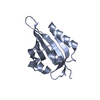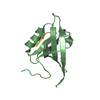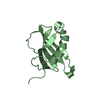+ Open data
Open data
- Basic information
Basic information
| Entry | Database: PDB / ID: 2n1v | ||||||
|---|---|---|---|---|---|---|---|
| Title | Solution structure of human SUMO1 | ||||||
 Components Components | Small ubiquitin-related modifier 1 | ||||||
 Keywords Keywords | STRUCTURAL GENOMICS / Ubiquitin-like protein | ||||||
| Function / homology |  Function and homology information Function and homology informationnegative regulation of potassium ion transmembrane transporter activity / protein localization to nuclear pore / : / SUMOylation of nuclear envelope proteins / SUMO is proteolytically processed / Negative regulation of activity of TFAP2 (AP-2) family transcription factors / SUMO is conjugated to E1 (UBA2:SAE1) / negative regulation of delayed rectifier potassium channel activity / PML body organization / negative regulation of DNA binding ...negative regulation of potassium ion transmembrane transporter activity / protein localization to nuclear pore / : / SUMOylation of nuclear envelope proteins / SUMO is proteolytically processed / Negative regulation of activity of TFAP2 (AP-2) family transcription factors / SUMO is conjugated to E1 (UBA2:SAE1) / negative regulation of delayed rectifier potassium channel activity / PML body organization / negative regulation of DNA binding / SUMO is transferred from E1 to E2 (UBE2I, UBC9) / negative regulation of action potential / nuclear stress granule / small protein activating enzyme binding / SUMOylation of DNA methylation proteins / SUMOylation of immune response proteins / SUMOylation of SUMOylation proteins / XY body / regulation of calcium ion transmembrane transport / Maturation of nucleoprotein / SUMOylation of RNA binding proteins / regulation of cardiac muscle cell contraction / Postmitotic nuclear pore complex (NPC) reformation / Maturation of nucleoprotein / negative regulation of protein import into nucleus / SUMOylation of ubiquitinylation proteins / transcription factor binding / ubiquitin-specific protease binding / cellular response to cadmium ion / roof of mouth development / SUMOylation of transcription factors / ubiquitin-like protein ligase binding / SUMOylation of DNA replication proteins / protein sumoylation / potassium channel regulator activity / Regulation of IFNG signaling / postsynaptic cytosol / transporter activator activity / nuclear pore / negative regulation of DNA-binding transcription factor activity / SUMOylation of DNA damage response and repair proteins / presynaptic cytosol / Transcriptional and post-translational regulation of MITF-M expression and activity / SUMOylation of transcription cofactors / SUMOylation of chromatin organization proteins / positive regulation of protein-containing complex assembly / SUMOylation of intracellular receptors / PML body / PKR-mediated signaling / regulation of protein stability / Formation of Incision Complex in GG-NER / protein tag activity / positive regulation of proteasomal ubiquitin-dependent protein catabolic process / Recruitment and ATM-mediated phosphorylation of repair and signaling proteins at DNA double strand breaks / regulation of protein localization / cellular response to heat / nuclear membrane / protein stabilization / nuclear speck / nuclear body / DNA repair / negative regulation of DNA-templated transcription / ubiquitin protein ligase binding / nucleolus / glutamatergic synapse / enzyme binding / RNA binding / nucleoplasm / nucleus / plasma membrane / cytosol Similarity search - Function | ||||||
| Biological species |  Homo sapiens (human) Homo sapiens (human) | ||||||
| Method | SOLUTION NMR / torsion angle dynamics, DGSA-distance geometry simulated annealing | ||||||
| Model details | lowest energy, model1 | ||||||
 Authors Authors | Naik, M.T. / Naik, N. / Shih, H. / Huang, T. | ||||||
 Citation Citation |  Journal: To Be Published Journal: To Be PublishedTitle: Structures of human SUMO Authors: Naik, M.T. / Naik, N. / Shih, H. / Huang, T. | ||||||
| History |
|
- Structure visualization
Structure visualization
| Structure viewer | Molecule:  Molmil Molmil Jmol/JSmol Jmol/JSmol |
|---|
- Downloads & links
Downloads & links
- Download
Download
| PDBx/mmCIF format |  2n1v.cif.gz 2n1v.cif.gz | 602.8 KB | Display |  PDBx/mmCIF format PDBx/mmCIF format |
|---|---|---|---|---|
| PDB format |  pdb2n1v.ent.gz pdb2n1v.ent.gz | 503.7 KB | Display |  PDB format PDB format |
| PDBx/mmJSON format |  2n1v.json.gz 2n1v.json.gz | Tree view |  PDBx/mmJSON format PDBx/mmJSON format | |
| Others |  Other downloads Other downloads |
-Validation report
| Summary document |  2n1v_validation.pdf.gz 2n1v_validation.pdf.gz | 546.6 KB | Display |  wwPDB validaton report wwPDB validaton report |
|---|---|---|---|---|
| Full document |  2n1v_full_validation.pdf.gz 2n1v_full_validation.pdf.gz | 1015.1 KB | Display | |
| Data in XML |  2n1v_validation.xml.gz 2n1v_validation.xml.gz | 69.8 KB | Display | |
| Data in CIF |  2n1v_validation.cif.gz 2n1v_validation.cif.gz | 90.3 KB | Display | |
| Arichive directory |  https://data.pdbj.org/pub/pdb/validation_reports/n1/2n1v https://data.pdbj.org/pub/pdb/validation_reports/n1/2n1v ftp://data.pdbj.org/pub/pdb/validation_reports/n1/2n1v ftp://data.pdbj.org/pub/pdb/validation_reports/n1/2n1v | HTTPS FTP |
-Related structure data
| Related structure data |  2n1wC  2n1x  2n1y  2n1z  2n20 C: citing same article ( |
|---|---|
| Similar structure data | |
| Other databases |
- Links
Links
- Assembly
Assembly
| Deposited unit | 
| |||||||||
|---|---|---|---|---|---|---|---|---|---|---|
| 1 |
| |||||||||
| NMR ensembles |
|
- Components
Components
| #1: Protein | Mass: 12768.236 Da / Num. of mol.: 1 / Fragment: UNP residues 1-97 Source method: isolated from a genetically manipulated source Source: (gene. exp.)  Homo sapiens (human) Homo sapiens (human)Description: Plasmid pCDF PylT-1 with SUMO insert and pAcKRS-3 as described in Neumann et al., Mol Cell, 36, 153, 2009 Gene: OK/SW-cl.43, SMT3C, SMT3H3, SUMO1, UBL1 / Production host:  |
|---|
-Experimental details
-Experiment
| Experiment | Method: SOLUTION NMR Details: Solution structure of Small Ubiquitin-related MOdifier 1. | ||||||||||||||||||||||||||||||||||||||||||||||||||||||||||||||||||||||||
|---|---|---|---|---|---|---|---|---|---|---|---|---|---|---|---|---|---|---|---|---|---|---|---|---|---|---|---|---|---|---|---|---|---|---|---|---|---|---|---|---|---|---|---|---|---|---|---|---|---|---|---|---|---|---|---|---|---|---|---|---|---|---|---|---|---|---|---|---|---|---|---|---|---|
| NMR experiment |
| ||||||||||||||||||||||||||||||||||||||||||||||||||||||||||||||||||||||||
| NMR details | Text: NMR data was acquired at 295K using Shigemi NMR tubes. |
- Sample preparation
Sample preparation
| Details |
| ||||||||||||||||||||||||||||||||||||||||||||||||||||||||||||||||||||||||||||||||||||||||||||||||||||||||||||||||||||||||||||||||||||||||||||||||||||||||||||
|---|---|---|---|---|---|---|---|---|---|---|---|---|---|---|---|---|---|---|---|---|---|---|---|---|---|---|---|---|---|---|---|---|---|---|---|---|---|---|---|---|---|---|---|---|---|---|---|---|---|---|---|---|---|---|---|---|---|---|---|---|---|---|---|---|---|---|---|---|---|---|---|---|---|---|---|---|---|---|---|---|---|---|---|---|---|---|---|---|---|---|---|---|---|---|---|---|---|---|---|---|---|---|---|---|---|---|---|---|---|---|---|---|---|---|---|---|---|---|---|---|---|---|---|---|---|---|---|---|---|---|---|---|---|---|---|---|---|---|---|---|---|---|---|---|---|---|---|---|---|---|---|---|---|---|---|---|---|
| Sample |
| ||||||||||||||||||||||||||||||||||||||||||||||||||||||||||||||||||||||||||||||||||||||||||||||||||||||||||||||||||||||||||||||||||||||||||||||||||||||||||||
| Sample conditions | pH: 6.5 / Pressure: ambient / Temperature: 290 K |
-NMR measurement
| NMR spectrometer |
|
|---|
- Processing
Processing
| NMR software |
| ||||||||||||||||||||||||||||||||||||||||
|---|---|---|---|---|---|---|---|---|---|---|---|---|---|---|---|---|---|---|---|---|---|---|---|---|---|---|---|---|---|---|---|---|---|---|---|---|---|---|---|---|---|
| Refinement | Method: torsion angle dynamics, DGSA-distance geometry simulated annealing Software ordinal: 1 Details: Initial structure ensemble was calculated by semi-automated NOESY assignment by CYANA. The assignments were manually verified in Sparky and final structure annealing was performed in CYANA. ...Details: Initial structure ensemble was calculated by semi-automated NOESY assignment by CYANA. The assignments were manually verified in Sparky and final structure annealing was performed in CYANA.Structure and restraints from CYANA were imported in Xplor-NIH for explicit water refinement., Initial structure ensemble was calculated by semi-automated NOESY assignment by CYANA. The assignments were manually verified in Sparky and final structure annealing was performed in CYANA.Structure and restraints from CYANA were imported in Xplor-NIH for explicit water refinement. | ||||||||||||||||||||||||||||||||||||||||
| NMR constraints | NOE constraints total: 2173 / NOE intraresidue total count: 402 / NOE long range total count: 713 / NOE medium range total count: 441 / NOE sequential total count: 617 / Disulfide bond constraints total count: 0 / Hydrogen bond constraints total count: 56 / Protein chi angle constraints total count: 0 / Protein other angle constraints total count: 0 / Protein phi angle constraints total count: 68 / Protein psi angle constraints total count: 68 | ||||||||||||||||||||||||||||||||||||||||
| NMR representative | Selection criteria: lowest energy | ||||||||||||||||||||||||||||||||||||||||
| NMR ensemble | Conformer selection criteria: structures with the lowest energy Conformers calculated total number: 400 / Conformers submitted total number: 20 / Maximum distance constraint violation: 0.56 Å / Maximum torsion angle constraint violation: 4.4 ° / Representative conformer: 1 / Torsion angle constraint violation method: PSVS 1.5 | ||||||||||||||||||||||||||||||||||||||||
| NMR ensemble rms | Distance rms dev: 0.03 Å |
 Movie
Movie Controller
Controller














 PDBj
PDBj















 HSQC
HSQC